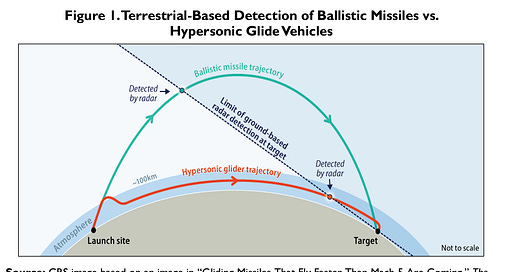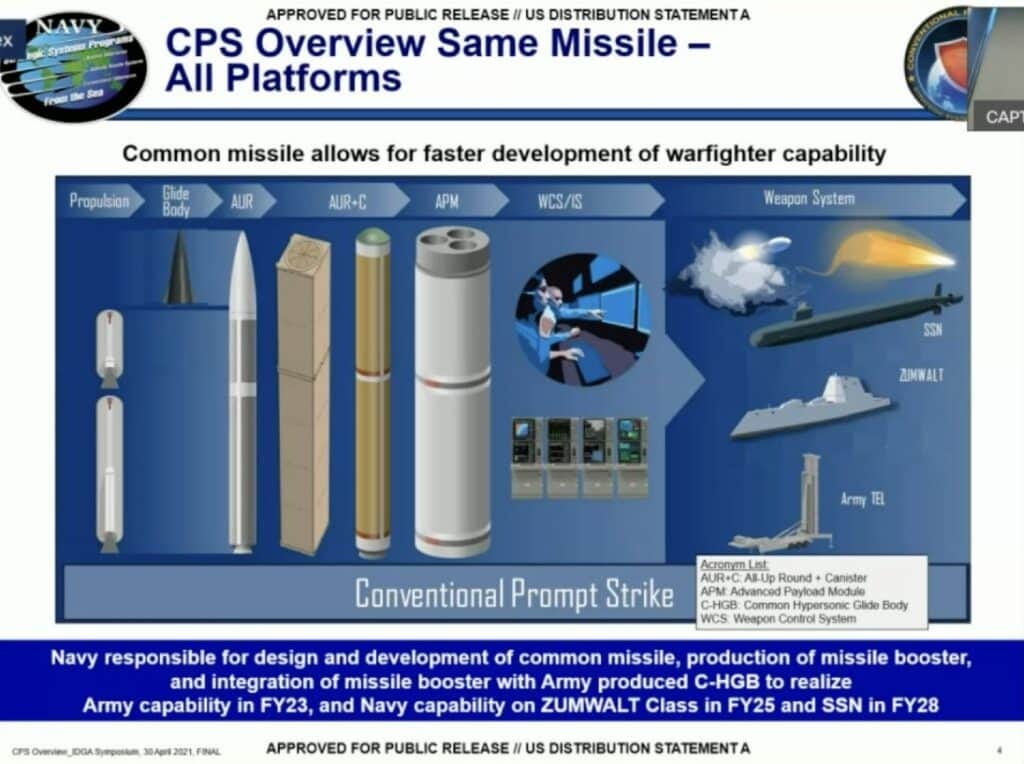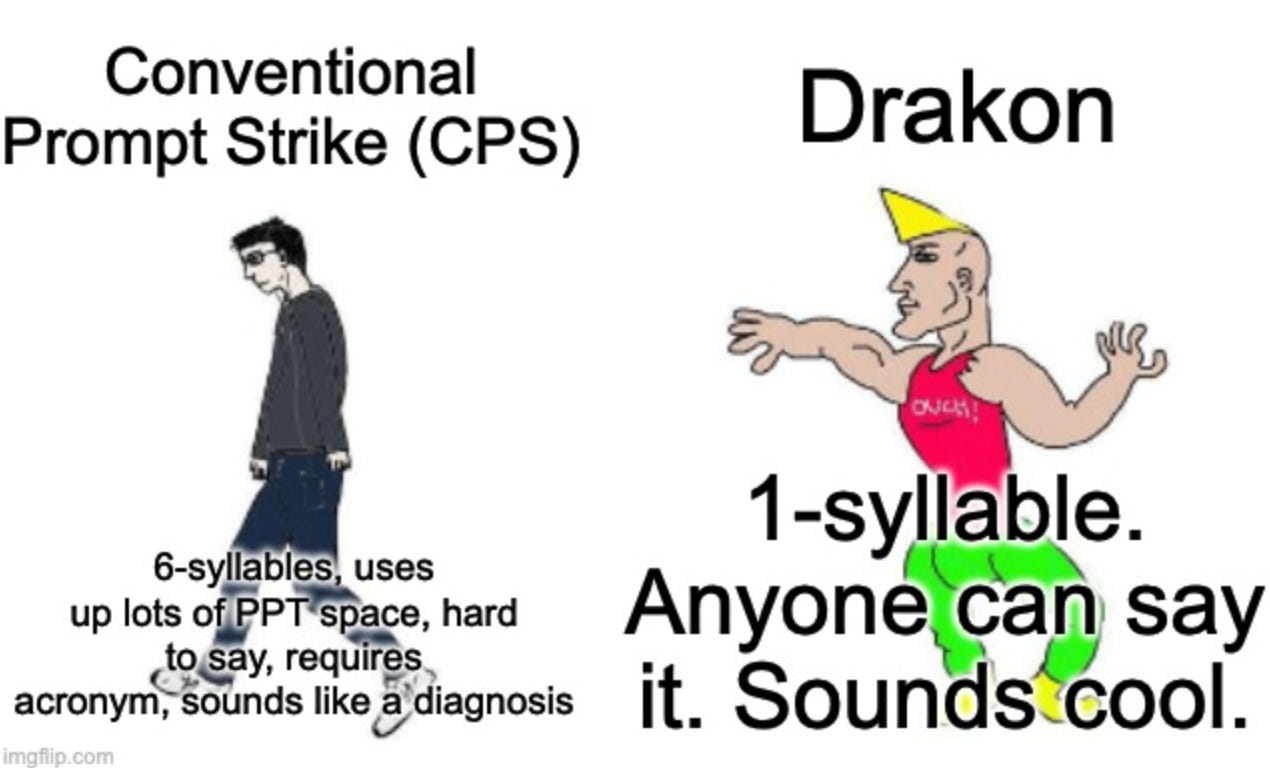“Present preparedness must not be sacrificed to an illusory future readiness. National emergencies cannot be foreseen and must be met by existing forces.”
- The General Board of the Navy, January 1933
That is on the email signature line of friend of the blog, regular Midrats guest, and all-around good guy, Dr. John T. Kuehn, CDR, USN (Ret.).
I’ve seen it many times, but it hit me Monday night because I just got through reading this from Bill Sweetman over at Real Clear Defense, A Progress Report on Hypersonics, that, as you will see, is a good companion piece to my post yesterday.
…the U.S. has taken a low-risk approach to its first-generation hypersonic weapon. It comprises a Common Hypersonic Glide Body (C-HGB) mated to a two-stage solid rocket booster stack…called Conventional Prompt Strike system.
The C-HGB is based on a 40-year-old design by Sandia National Laboratories. … the missile weighs a reported 7400kg to deliver a small 225 kg payload over 3000 km (and) is expected to cost $50 million per round, but most of the life-cycle cost of such a large weapon goes into the platform that moves and protects it. Because the Conventional Prompt Strike weapon is too large for standard vertical launch system tubes, the U.S. Navy is putting it on its three Zumwalt-class destroyers, replacing the two 155 mm guns (for which the Navy never procured ammunition). Each of these 15,900-tonne ships would carry just 12 missiles. Nine of the ten Block V Virginia-class attack submarines, priced at $4.3 billion each, will also be able to carry 12.
But here’s one reason why hypersonic weapons may not be very useful for the U.S. in the Western Pacific: the only ones that would be available for prompt strike would be those in vessels that were within range when a conflict starts. Not many.
China doesn’t have that problem. DF-17s are carried on trucks and most of the people operating them need about the same level of training as a mobile crane crew. Just about the whole stock can be available for firing from day one.
The Navy just refers to it as Conventional Prompt Strike (CPS) in most cases, so we’ll use that, though I really wish they gave it a real cool name. I would—sticking with the Greek mythological characters—recommend “Drakon.”
Drakons, in Greek"δράκους" and "dracones" in Latin were giant, usually wingless serpents, some with one others with multiple heads, who could breathe fire and/or spit deadly poison.
That’s a cool name, presently untaken for a weapon. Ahem.
Are HGB really that much of an additional tool in the weaponeering box? As time-distance-reaction-intercept is a real problem...yes.
From the CRS report from last month:
I think that demonstrates the issue quite well. You can do the rest yourself.
However, like rail guns and directed energy, none of this is going to show up in any tactically or operationally significant numbers any time soon.
In a June 2018 memorandum, DOD announced that the Navy would lead the development of a Common Hypersonic Glide Body for use across the services.26 The glide body is being adapted from a Mach 6 Army prototype warhead, the Alternate Re-Entry System. The Navy’s CPS is expected to pair the glide body with a booster system to create a common All Up Round (AUR) for use by both the Navy and Army. The first test of the AUR, conducted in June 2022, resulted in failure.27 Subsequent flight tests, including those planned for March and September 2023, did not occur due to failed preflight checks.28 DOD completed a test of the AUR in June 2024.29 According to the Navy’s FY2025 budget documents, the service intends to deploy CPS on Zumwalt-class destroyers by the end of FY2025.30 Although Navy officials have previously noted plans to achieve “limited operating capability” on Ohio-class submarines as early as 202531 and on Virginia-class submarines by FY2028, as well as to eventually field hypersonic weapons on Burke-class destroyers, such plans are not reflected in current budget documents.32 The Navy is requesting $903.9 million for CPS RDT&E in FY2025—an increase from the FY2024 request of $901.1 million.33 The Navy did not request funding for CPS procurement in FY2025.34 The Navy is also developing the Offensive Anti-Surface Warfare Increment 2 (OASuW Inc 2), also known as Hypersonic Air-Launched OASuW (HALO)—a new start in FY2023.35 Although few details about the program have been released publicly, HALO is likely to be compatible with the Navy’s F/A-18 fighter jet.36 The Navy is requesting $178.6 million for HALO RDT&E in FY2025.37
Right now, we have a fight to get ready for…as many of us have been saying for <checks notes> the last two decades.
We need to focus as much energy making sure, from existing submarines needing maintenance to opening a second yard for Constellation Class FFG construction, that we redouble efforts on what we have going now that we can send to the fight in usable numbers in the next decade.
Super Hornets, to Poseidons; King Stallions to C-130Js; 155mm rounds to as many TLAMs and SM-6s as three shifts can give us.
CPS, or Drakon if we were cool, could be part of the capabilities we bring to the table if the war comes on the right side of the Davidson Window, but it will not be the key to determining victory or defeat.
We need to be careful to respect the opportunity cost. We already lost one generation in vanity during the Age of Transformation. We cannot afford to lose another.







Good God even Stevie Wonder can see this is a waste of money and resources. We need to increase the amount of the current systems we are employing now. Not “future capabilities for the warfighter”. If we dither we won’t have warfighters. Only casualties.
Hate to come back again with more negative vibes, but at that price point, I'm not a fan. If goes 3000k, why not put it on land?
As for the name, Pershing is available again.
Buy more SM-6
PS: put Elon on it, I'll bet he can build a reusable booster that dramaticly lowers the price. Alternately, load Falcon 9's with iron rods not Starlink